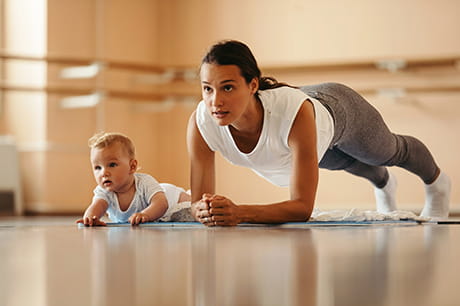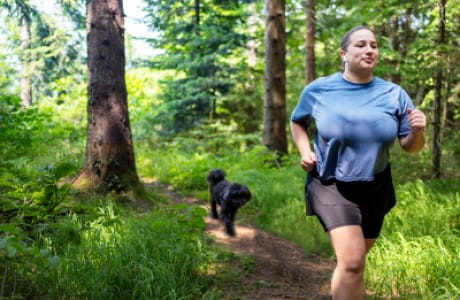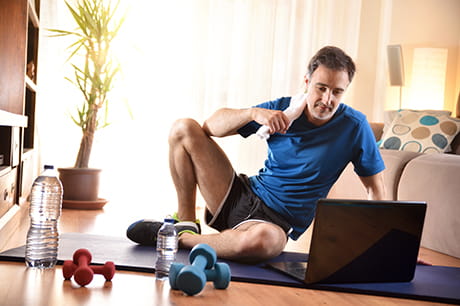Why core strength is better than six-pack abs
Sorry, six-pack fans. Rippling abs might look nice, but building core strength, front and back, is a better fitness goal.
Who hasn’t stood in line at the grocery store, spied the midriff-baring model on a fitness magazine and thought, “In spite of buying organic, fat-free everything — and doing a gazillion crunches — I’ll never achieve that.”
Take heart, exercise enthusiast. The days of six-pack-ab fixation are over. The new standard for true fitness is a strong core. And core strength is about much more than showing off washboard abs.
In fact, those hyper-cut abdominals might do more harm than good.
Aim instead for achievable core strength and you’ll stabilize your back, have more overall power and protect yourself from injuries — long after you want to bare your belly in public.
What, exactly, is your “core”?
Basically, your core muscles span your entire midsection, front, back and sides, says Gus Turonis, wellness associate with Geisinger 65 Forward in Wilkes-Barre. Along with your abs, your core muscles include your hips, buttocks, pelvic floor, diaphragm and all your back muscles. That’s 29 muscles in total, with formal names including:
- Rectus abdominus, your abs
- Gluteus maximus and minimus, your hips and rear
- Erector spinae, along your spine
- Adductors, in your inner thigh
No need to memorize the names, though. Just keep in mind that your core is more than your abs.
“Your core muscles make up a significant percentage of your body, and your goal should be to keep the entire region strong,” says Mr. Turonis. “Each muscle group contributes to your ability to bend, lift things, stay balanced — basically move with ease and function safely, day to day, at any age.”
Exercises to strengthen your core
Many exercises that target the abs — we’re talking about you, crunches — ignore other vital core muscles. That might not seem like a bad thing, especially if you love the look of washboard abs.
But overdeveloping your abs, at the expense of the rest of your core, actually puts you out of balance. Consider your diet. Carrots are healthy. But if you eat them constantly, and you’re skipping beets, broccoli, grains and all that other good stuff, you’re missing out on vital nutrients. Think about your core muscles the same way. You want your back, buttocks and pelvic floor to be just as strong as your abs.
And doing too many crunches can put a strain on your spine, especially if you make the common mistake of pulling on your head when you crunch.
Instead, try some of these exercises and balance out your body.
Challenge your core with planks
Holding yourself in plank position might seem like a piece of cake. You’re not even moving. But if you haven’t done many plank exercises, you might find it difficult to last 30 seconds the first time you try.
Start by perfecting the basic plank exercise, with your hands and toes on the floor and every muscle you can feel held taut, so you can keep your body in a perfect line. The slightly more advanced option is on your elbows instead of hands.
“It’s important to keep your butt down,” says Mr. Turonis. “If you start to pike, the exercise isn’t as effective.”
See how long you can hold a plank with perfect form, then begin to add time and variations, such as:
- Side planks
- Walking planks
- Ball planks, with an exercise ball
“Plank exercises are surprisingly varied and work your entire core,” Mr. Turonis adds. “They’re one of the most efficient and effective core-strengthening exercises you can do.”
Alternating bird dogs for a strong core
This simple exercise helps you build better posture, get relief from low-back pain and improve your range of motion, according to Mr. Turonis.
- Get down on your hands and knees, with your hands directly under your shoulders. Keep your abs held strong to support your back.
- Extend one arm and the opposite leg and hold for a few seconds.
- Repeat with the other arm and leg for several sets.
“Be sure you don’t twist,” Mr. Turonis notes. “If you do bird dogs correctly, they’re great for your shoulders, upper back, glutes and many other muscles that contribute to core strength.”
Float like a butterfly with flutter kicks
Flutter kicks might sound dainty. But don’t let the delicate name fool you. Hold the position and kick long enough, and your lower abs in particular will cry out for mercy. Which is a good thing.
- Lie on your back, your neck and head relaxed and arms by your sides.
- Lift your legs just off the ground and kick up and down, without letting your heels touch down. The range of motion should be about eight to 10 inches.
- Repeat for as long as you’re comfortable and your back doesn’t arch. Stop if your back arches to prevent injury.
“Lower abs are difficult to target and often overlooked,” says Mr. Turonis. “This exercise is good for some of those deeper muscles and your hip flexors.”
Who has a strong core? Superman, of course.
Sure, he also has pretty nice ab definition. But Superman (probably) knows the benefits of overall core strength. Get the same power with a simple exercise named for how he looks flying through Metropolis.
- Lie facedown with arms and legs extended.
- Engage your glutes, abs and back muscles to lift your arms and legs off the floor. The movement is small — just a few inches. Don’t hyperextend and keep your neck straight, chin down.
- Hold for two to three seconds and release.
- Repeat as many times as you’re comfortable.
“Supermans are a great exercise for strengthening the muscles along your spine and preventing injuries,” says Mr. Turonis.
A few reminders when strengthening your core
If you have existing injuries, especially to your back, or any health concerns, be sure to talk to your doctor before doing the exercises listed above.
“If you don’t already have an exercise routine, it’s always smart to discuss how to get started with a doctor or other healthcare professional,” says Mr. Turonis, who provides guidance to clients 65 and older at 65 Forward. “The goal is to protect your body at each stage of life. That can mean starting small and working toward bigger goals.”
Once you get the go-ahead and have a plan in place, strengthening your core is a great investment in your overall health. And you don’t even need any special equipment.
“Many core-strengthening exercises can be done with body weight,” Mr. Turonis notes. “All you need is time and the proper form to get muscles that will keep you balanced, improve your posture and help you stay active for years to come.”
Next steps:
How much exercise do you need?
Thinking about yoga? Read the 5 research-backed health benefits
Learn more about Geisinger 65 Forward





